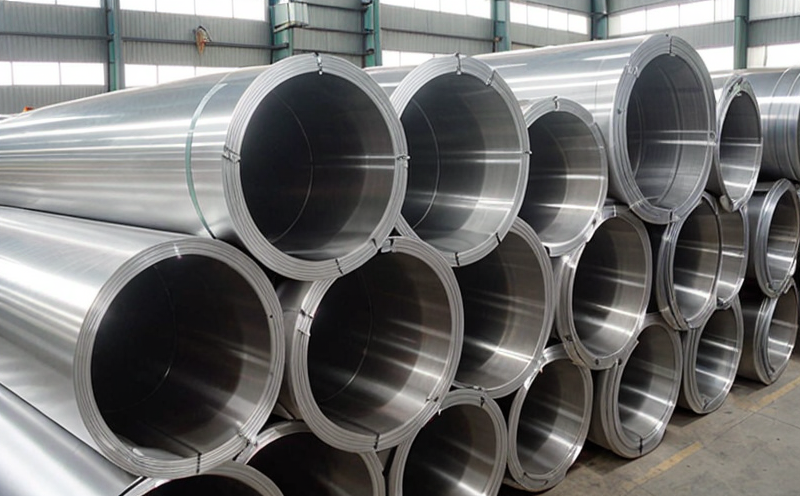ISO 4892-3 Xenon Arc Accelerated Weathering Testing
The ISO 4892-3 standard is an internationally recognized method for evaluating the resistance of materials and products to weathering, specifically focusing on ultraviolet (UV) light, heat, moisture, and other environmental factors. This accelerated testing technique simulates the effects of a year or more of outdoor exposure in just days or weeks.
The Xenon Arc test is particularly relevant for marine and ship equipment, as it helps manufacturers ensure that materials used in these environments are durable and can withstand harsh conditions such as salt spray, humidity, and sunlight. The testing process involves exposing specimens to a continuous xenon arc lamp which emits UV radiation similar to midday sunlight, along with water or steam to simulate the effects of rain.
For aluminium materials specifically, this type of accelerated weathering test is crucial because it helps identify how well the material will perform under real-world conditions. Aluminium is widely used in marine and shipbuilding industries due to its strength-to-weight ratio and corrosion resistance properties, but prolonged exposure to environmental factors can still lead to degradation over time.
The test setup typically includes a chamber containing a xenon arc lamp that emits radiation at wavelengths from 280 nm to 400 nm, which closely mimics the spectrum of sunlight. The specimen is placed in front of this lamp and exposed for varying durations depending on the desired outcome—ranging from hours to days per cycle.
During testing, temperature control plays a key role; it can be adjusted within a range of 50°C to 70°C to simulate different environmental conditions. Additionally, humidity levels are often controlled using water or steam injection into the chamber. The combination of these factors allows for precise simulation of real-world weathering effects.
After exposure, specimens undergo detailed examination by our highly skilled technicians who assess changes such as color change, loss in glossiness, cracking, and other signs indicative of degradation. Specimens are then compared against industry standards to determine whether they meet required performance criteria.
Why It Matters
The ISO 4892-3 Xenon Arc Accelerated Weathering Testing is essential for ensuring the longevity and reliability of marine and ship equipment components made from aluminium materials. By simulating years' worth of environmental exposure in a controlled setting, this testing method provides valuable insights into potential performance issues before products reach end users.
For quality managers and compliance officers, this test ensures that products meet regulatory requirements related to durability and safety standards. For R&D engineers, it offers critical data for improving product designs by identifying weak points early in the development process. Meanwhile, procurement teams benefit from knowing which suppliers provide materials capable of withstanding harsh marine environments.
Moreover, understanding how materials behave under accelerated weathering conditions helps manufacturers make informed decisions about selecting appropriate coatings and finishes that enhance corrosion resistance further. This not only prolongs product life but also reduces maintenance costs associated with premature failure.
Scope and Methodology
| Parameter | Specification |
|---|---|
| Light Source | Xenon Arc Lamp emitting UV light from 280 nm to 400 nm |
| Temperature Range | 50°C to 70°C |
| Humidity Control | Water or steam injection for humidity simulation |
| Test Parameter | Duration (Hours) |
|---|---|
| UV Radiation Exposure | 16 hours per cycle |
| Heat Cycling | 4 hours at 70°C |
| Cooling Period | 3.5 hours at room temperature |
The testing process begins by preparing the specimens according to specified dimensions and orientations. Once ready, they are placed inside a controlled environment chamber where continuous UV radiation is emitted for set periods followed by thermal cycling and humidity exposure.
After completing all cycles, the specimens are removed from the chamber and thoroughly inspected using visual methods or more advanced analytical techniques such as Fourier Transform Infrared Spectroscopy (FTIR) to quantify any changes observed. Acceptance criteria vary based on specific material properties being tested; however, generally accepted standards include maintaining color stability within defined limits.
Environmental and Sustainability Contributions
The use of ISO 4892-3 Xenon Arc Accelerated Weathering Testing contributes positively towards environmental sustainability by providing an efficient means to assess material performance without the need for extensive field testing. This reduces resource consumption associated with traditional outdoor exposure tests while still yielding accurate results.
By ensuring that materials used in marine and ship equipment meet stringent durability requirements, this testing process supports efforts aimed at reducing waste generation from premature product failures. Additionally, it encourages innovation in developing longer-lasting products which ultimately contribute to reduced carbon footprints through extended operational lifetimes.





